Case Studies about Finite Element Modeling and Wireless Sensing of Three Pennsylvania Bridges
Abstract
1. Introduction
2. The Structures
3. Instrumentation and Truck Test Setup
4. Modeling: Setup and Simulated Damage
5. Truck Test Results and Comparison to the Numerical Analyses
5.1. Birmingham Bridge
5.2. Clairton–Glassport Bridge
5.3. Chester Bridge
6. Long-Term Monitoring
6.1. Raw Strain Data
6.2. Raw Strain–Temperature Analysis
6.3. Live Load Analysis
7. Conclusions
Author Contributions
Funding
Institutional Review Board Statement
Informed Consent Statement
Data Availability Statement
Acknowledgments
Conflicts of Interest
References
- Gibson, B.; Van Dyke, C.; Palle, S.; Griffith, R.; Kreis, D. Bridge Project Prioritization; Report No. KTC-22-08/SPR21-599-1F; Kentucky Transportation Center: Lexington, KY, USA, 2022. [Google Scholar] [CrossRef]
- Salkhordeh, M.; Mirtaheri, M.; Rabiee, N.; Govahi, E.; Soroushian, S. A Rapid Machine Learning-Based Damage Detection Technique for Detecting Local Damages in Reinforced Concrete Bridges. J. Earthq. Eng. 2023, 27, 4705–4738. [Google Scholar] [CrossRef]
- Flanigan, K.A.; Lynch, J.P.; Ettouney, M. Probabilistic fatigue assessment of monitored railroad bridge components using long-term response data in a reliability framework. Struct. Health Monit. 2020, 19, 2122–2142. [Google Scholar] [CrossRef]
- Cawley, P. A Development Strategy for Structural Health Monitoring Applications. ASME J. Nondestruct. Eval. 2021, 4, 041012. [Google Scholar] [CrossRef]
- Danish, A.; Tayyab, F.; Salim, M.U. Health assessment based on dynamic characteristics of reinforced concrete beam using realtime wireless structural health monitoring sensor. J. Struct. Integr. Maint. 2020, 5, 204–210. [Google Scholar] [CrossRef]
- Jonnalagadda, S.; Ross, B.E.; Khademi, A. A modelling approach for evaluating the effects of design variables on bridge condition ratings. J. Struct. Integr. Maint. 2016, 1, 167–176. [Google Scholar] [CrossRef]
- Moomen, M.; Siddiqui, C. Probabilistic deterioration modeling of bridge component condition with random effects. J. Struct. Integr. Maint. 2022, 7, 151–160. [Google Scholar] [CrossRef]
- Sun, Z.; Sun, H. Jiangyin Bridge: An example of integrating structural health monitoring with bridge maintenance. Struct. Eng. Int. 2018, 28, 353–356. [Google Scholar] [CrossRef]
- Cremona, C.; Santos, J. Structural health monitoring as a big-data problem. Struct. Eng. Int. 2018, 28, 243–254. [Google Scholar] [CrossRef]
- Rizzo, P.; Enshaeian, A. Bridge Health Monitoring in the United States: A Review. Struct. Monit. Maint. Int. J. 2021, 8, 1–50. [Google Scholar] [CrossRef]
- Shenton, H.W.; Al-Khateeb, H.T.; Chajes, M.J.; Wenczel, G. Indian river inlet bridge (part A): Description of the bridge and the structural health monitoring system. J. Bridge Struct. 2017, 13, 3–13. [Google Scholar] [CrossRef]
- Shahsavari, V.; Mehrkash, M.; Santini-Bell, E. Damage detection and decreased load-carrying capacity assessment of a vertical-lift steel truss bridge. J. Perform. Constr. Facil. 2020, 34, 04019123. [Google Scholar] [CrossRef]
- Pines, D.; Aktan, A.E. Status of structural health monitoring of long span bridges in the United States. Progress Struct. Eng. Mater. 2002, 4, 372–380. [Google Scholar] [CrossRef]
- Colombani, I.A.; Andrawes, B. A study of multi-target image-based displacement measurement approach for field testing of bridges. J. Struct. Integr. Maint. 2022, 7, 207–216. [Google Scholar] [CrossRef]
- Betti, R.; Sloane, M.; Khazem, D.; Gatti, C. Monitoring the structural health of main cables of suspension bridges. J. Civ. Struct. Health Monit. 2016, 6, 355–363. [Google Scholar] [CrossRef]
- Anay, R.; Lane, A.; Jáuregui, D.V.; Weldon, B.D.; Soltangharaei, V.; Ziehl, P. On-site acoustic-emission monitoring for a prestressed concrete BT-54 AASHTO girder bridge. J. Perform. Constr. Facil. 2020, 34, 04020034. [Google Scholar] [CrossRef]
- Yu, A.; Liu, X.; Fu, F.; Chen, X.; Zhang, Y. Acoustic Emission Signal Denoising of Bridge Structures Using SOM Neural Network Machine Learning. J. Perform. Constr. Facil. 2023, 37, 04022066. [Google Scholar] [CrossRef]
- Li, X.; Glisic, B. Integrating finite element modeling with sensing system for monitoring composite structures using the method of neutral axis. Struct. Eng. Int. 2019, 29, 8–17. [Google Scholar] [CrossRef]
- Svendsen, B.T. Numerical and Experimental Studies for Damage Detection and Structural Health Monitoring of Steel Bridges. Ph.D. Dissertation, Norwegian University of Science and Technology, Trondheim, Norway, 2021. Available online: https://ntnuopen.ntnu.no/ntnu-xmlui/handle/11250/2978371 (accessed on 20 September 2023).
- Svendsen, B.T.; Petersen, Ø.W.; Frøseth, G.T.; Rønnquist, A. Improved finite element model updating of a full-scale steel bridge using sensitivity analysis. Struct. Infrastruct. Eng. 2022, 19, 315–331. [Google Scholar] [CrossRef]
- Park, J.W.; Sherman, R.J.; Aslam, H.; Kalkan, E. Galena Creek Bridge Health Monitoring Instrumentation; Report No. 743-18-803; Nevada Department of Transportation: Las Vegas, NV, USA, 2022. [Google Scholar]
- Sharma, S.; Dangi, S.K.; Bairwa, S.K.; Sen, S. Comparative study on sensitivity of acceleration and strain responses for bridge health monitoring. J. Struct. Integr. Maint. 2022, 7, 238–251. [Google Scholar] [CrossRef]
- Kaloop, M.R.; Hwang, W.S.; Elbeltagi, E.; Beshr, A.; Hu, J.W. Evaluation of Dorim-Goh bridge using ambient trucks through short-period structural health monitoring system. Struct. Eng. Mech. 2019, 69, 347–359. [Google Scholar]
- Kaloop, M.R.; Kim, K.H.; Elsharawy, M.; Zarzoura, F.; Hu, J.W. Performance Assessment Using a Field Test of a Short-Period Monitoring System: Tun Bridge Case Study. Struct. Eng. Int. 2019, 29, 600–612. [Google Scholar] [CrossRef]
- Hedegaard, B.D.; French, C.E.; Shield, C.K.; Stolarski, H.K.; Jilk, B.J. Instrumentation and modeling of I-35W St. Anthony Falls bridge. J. Bridge Eng. 2013, 18, 476–485. [Google Scholar] [CrossRef]
- Yu, S.; Ou, J. Structural Health Monitoring and Model Updating of Aizhai Suspension Bridge. J. Aerosp. Eng. 2017, 30, B4016009. [Google Scholar] [CrossRef]
- He, X.H.; Yu, Z.W.; Chen, Z.Q. Finite Element Model Updating of Existing Steel Bridge Based on Structural Health Monitoring. J. Cent. South Univ. Technol. 2008, 15, 399–403. [Google Scholar] [CrossRef]
- Zong, Z.; Lin, X.; Niu, J. Finite element model validation of bridge based on structural health monitoring—Part I: Response surface-based finite element model updating. J. Traffic Transp. Eng. 2015, 2, 258–278. [Google Scholar] [CrossRef]
- Duan, Y.F.; Xu, Y.L.; Fei, Q.G.; Wong, K.Y.; Chan, K.W.Y.; Ni, Y.Q.; Ng, C.L. Advanced Finite Element Model of Tsing Ma Bridge for Structural Health Monitoring. Int. J. Struct. Stab. Dyn. 2011, 11, 313–344. [Google Scholar] [CrossRef]
- Rojas-Mercedes, N.; Erazo, K.; Di Sarno, L. Seismic fragility curves for a concrete bridge using structural health monitoring and digital twins. Earthq. Struct. 2022, 22, 503–515. [Google Scholar]
- Bagheri, A.; Pistone, E.; Rizzo, P. Outlier Analysis and Artificial Neural Network for the Noncontact Nondestructive Evaluation of Immersed Plates. Res. Nondestruct. Eval. 2015, 26, 154–173. [Google Scholar] [CrossRef]
- Pamwani, L.; Agarwal, V.; Shelke, A. Damage Classification and Feature Extraction in Steel Moment-Resisting Frame Using Time-Varying Autoregressive Model. ASME J. Nondestruct. Eval. 2019, 2, 021002. [Google Scholar] [CrossRef]
- Rizzo, P.; Sorrivi, E.; Lanza di Scalea, F.; Viola, E. Wavelet-Based Outlier Analysis for Guided Wave Structural Monitoring: Application to Multi-wire Strands. J. Sound Vib. 2007, 307, 52–68. [Google Scholar] [CrossRef]
- Rizzo, P.; Lanza di Scalea, F. Wavelet-based Unsupervised and Supervised Learning Algorithms for Ultrasonic Structural Monitoring of Waveguides. In Progress in Smart Materials and Structures Research; Reece, P.L., Ed.; NOVA Publishers: Hauppauge, NY, USA, 2007; pp. 227–290. [Google Scholar]
- Worden, K.; Manson, G.; Fieller, N.R. Damage detection using outlier analysis. J. Sound Vib. 2000, 229, 647–667. [Google Scholar] [CrossRef]
- Worden, K.; Manson, G.; Allman, D. Experimental validation of a structural health monitoring methodology: Part I. Novelty detection on a laboratory structure. J. Sound Vib. 2003, 259, 323–343. [Google Scholar] [CrossRef]
- Zheng, B.; Rizzo, P.; Nasrollahi, A. Outlier Analysis of Nonlinear Solitary Waves for Health Monitoring Applications. Struct. Health Monit. 2020, 19, 1160–1174. [Google Scholar] [CrossRef]
- Ghahremani, B.; Enshaeian, A.; Rizzo, P. Bridge Health Monitoring using Strain Data and High-Fidelity Finite Element Analysis. Sens. J. 2022, 22, 5172. [Google Scholar] [CrossRef]
- ASTM A36/A36M; Standard Specification for Carbon Structural Steel. American Society for Testing and Materials (ASTM): West Conshohocken, PA, USA, 2019.
- ASTM A572/A572M-12; Standard Specification for High-Strength Low-Alloy Columbium-Vanadium Structural Steel. American Society for Testing and Materials (ASTM): West Conshohocken, PA, USA, 2017.
- ASTM A588/A588M-19; Standard Specification for High-Strength Low-Alloy Structural Steel, up to 50 ksi [345 MPa] Minimum Yield Point, with Atmospheric Corrosion Resistance. American Society for Testing and Materials (ASTM): West Conshohocken, PA, USA, 2019.


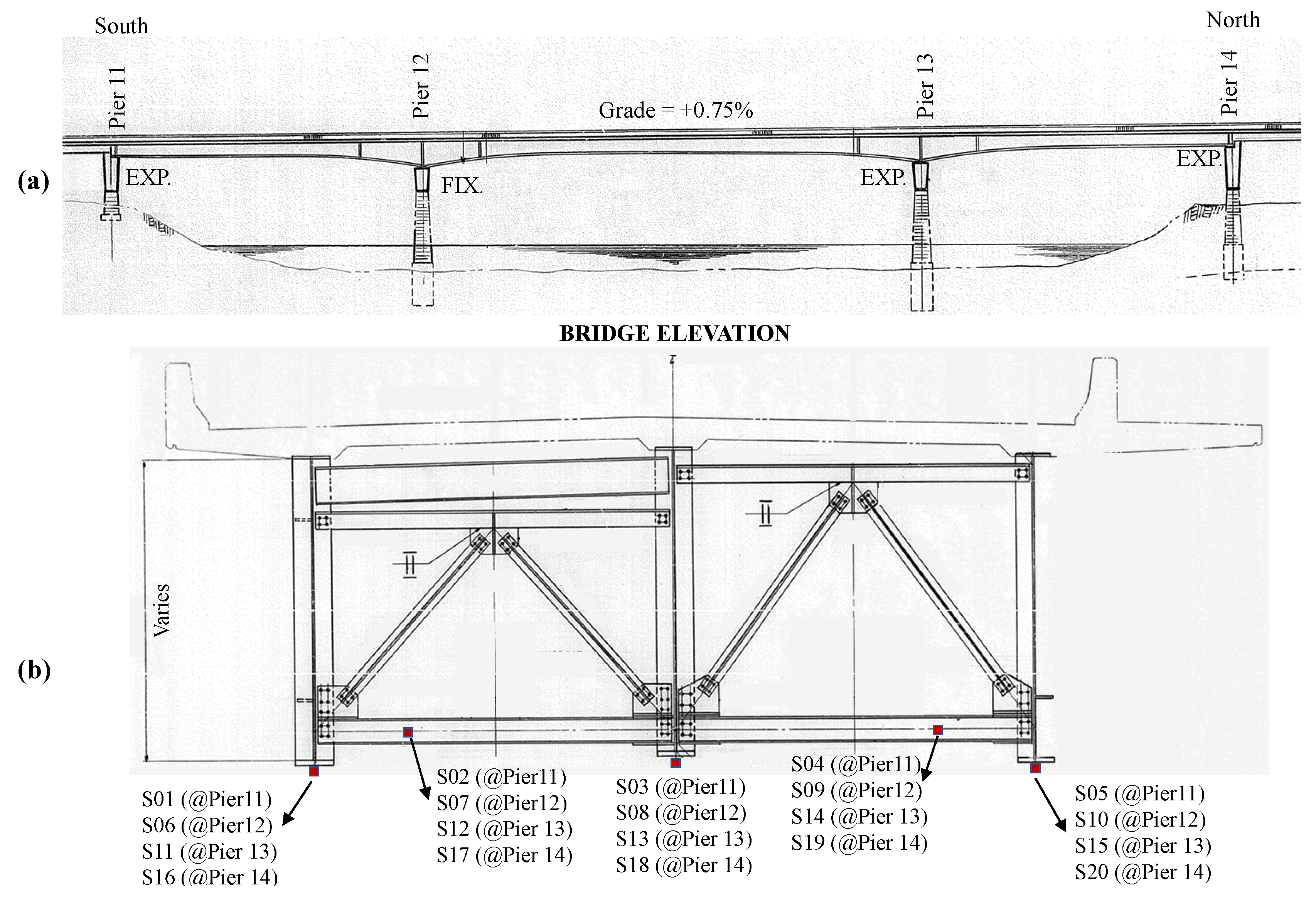
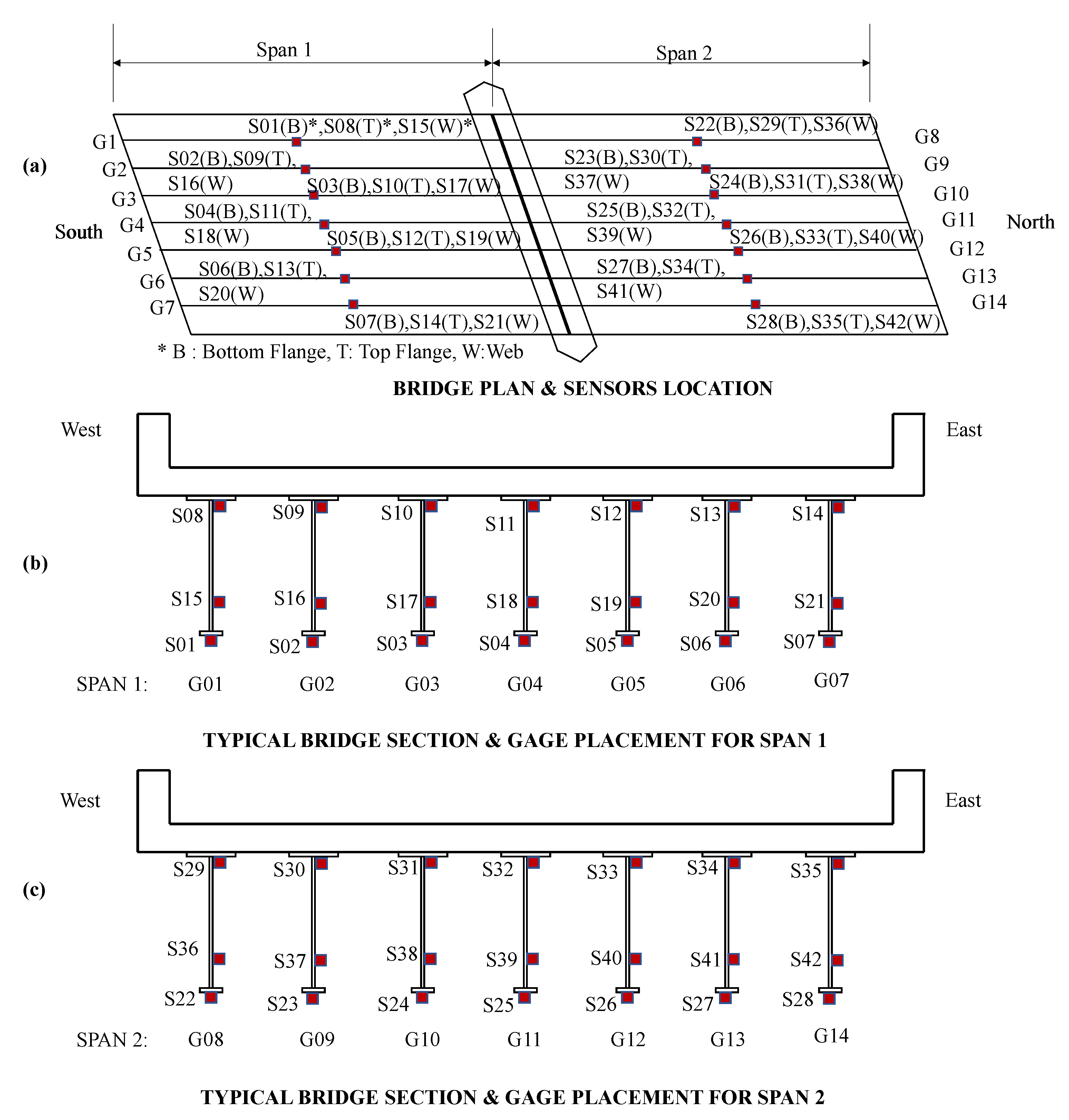
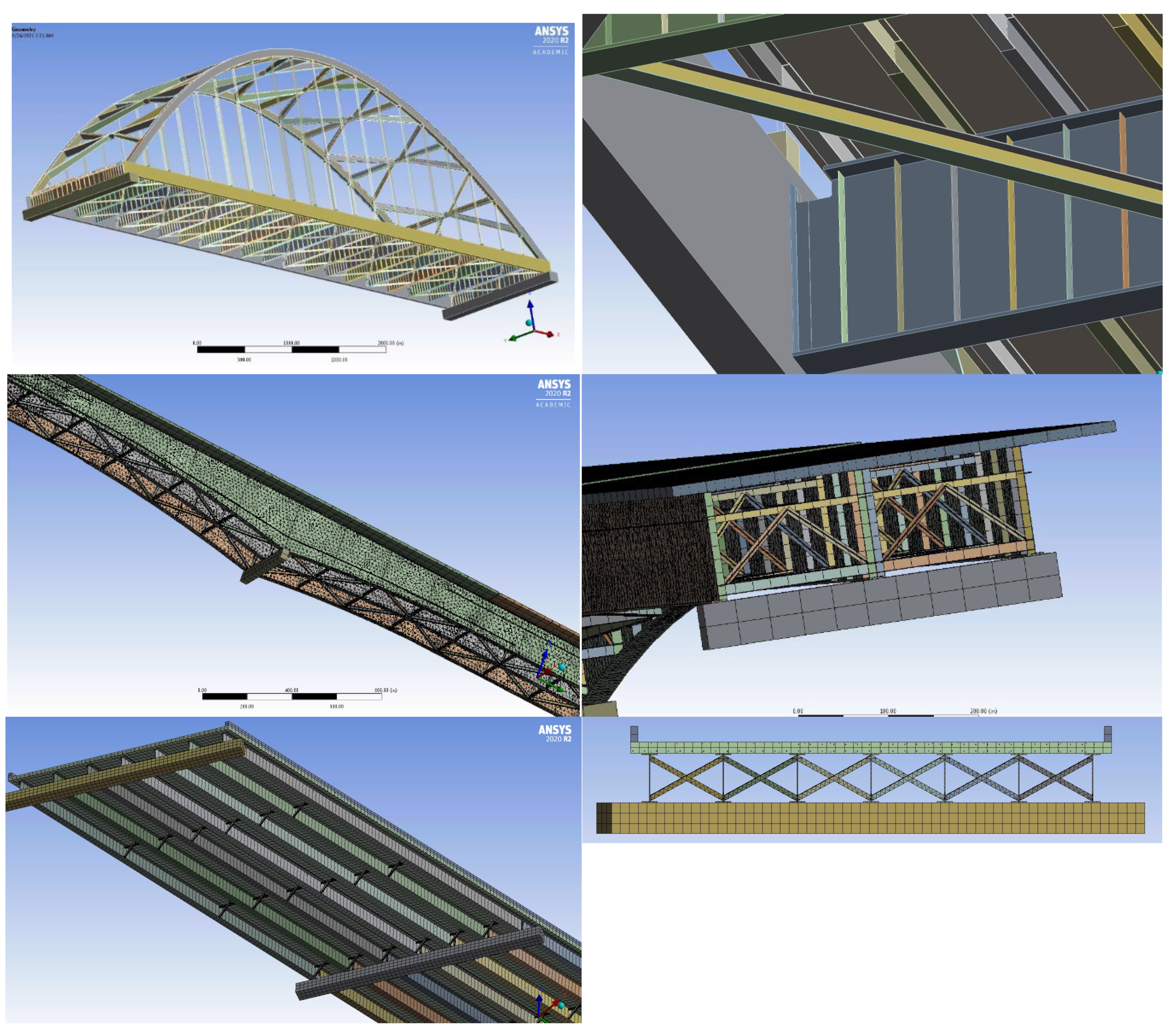

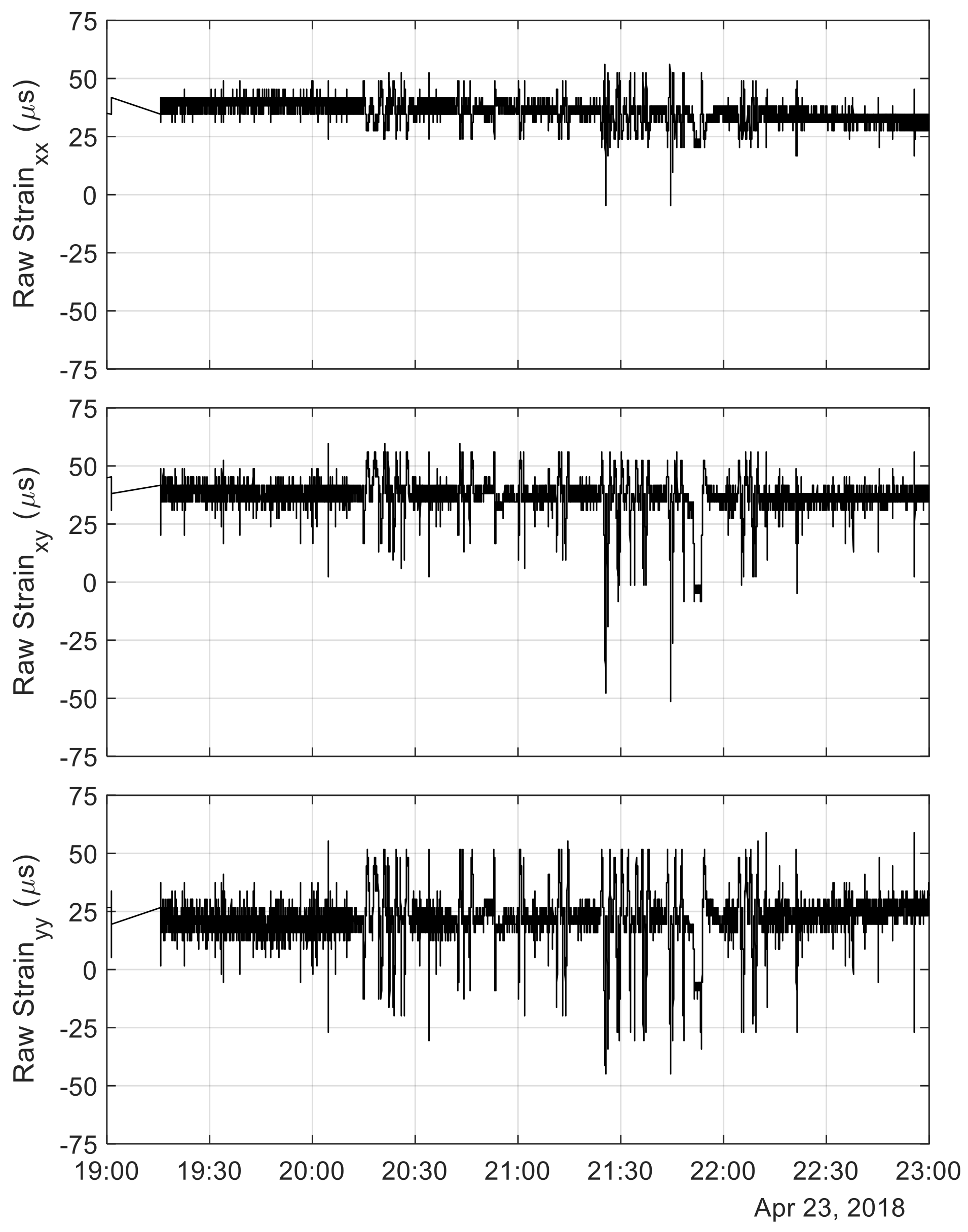

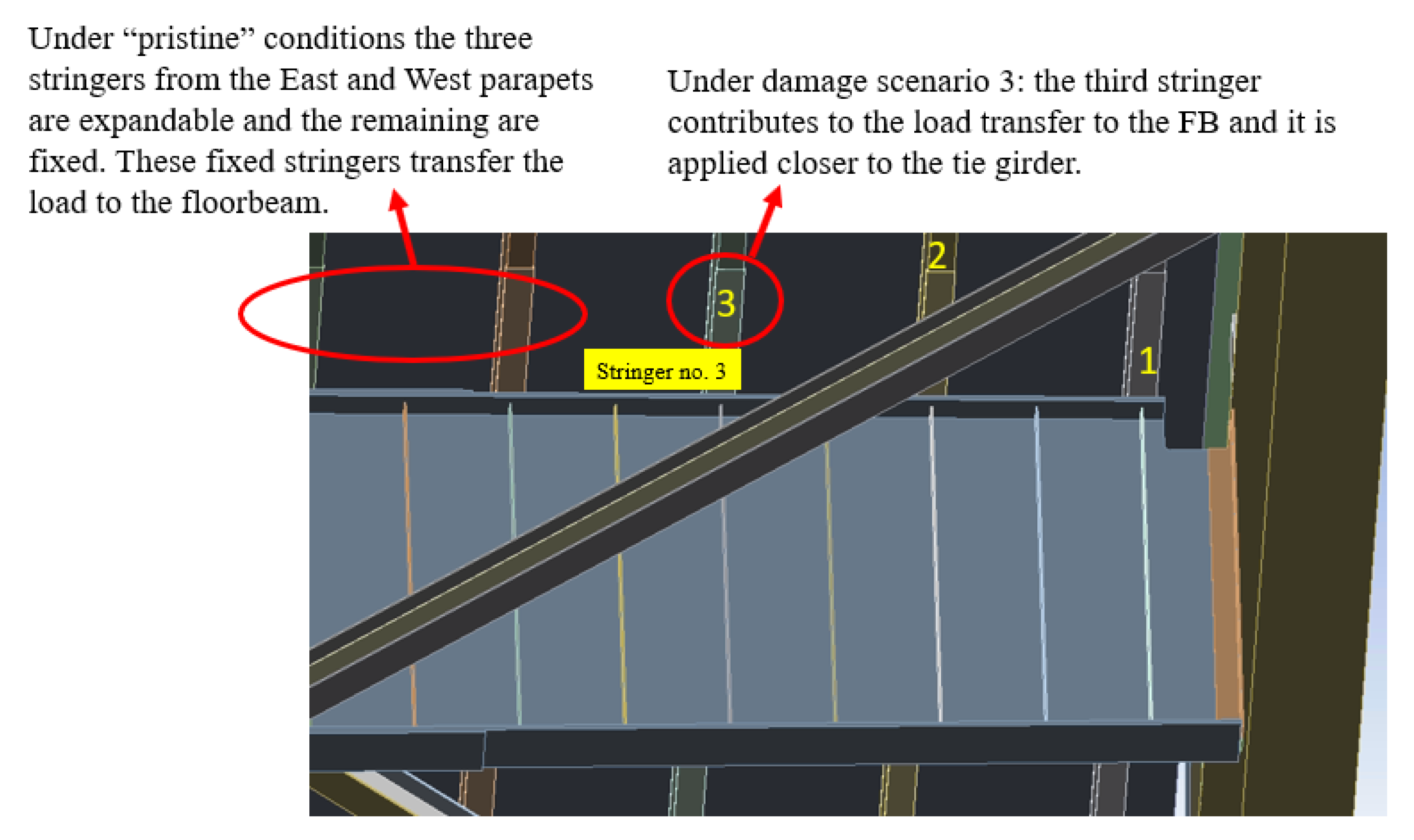


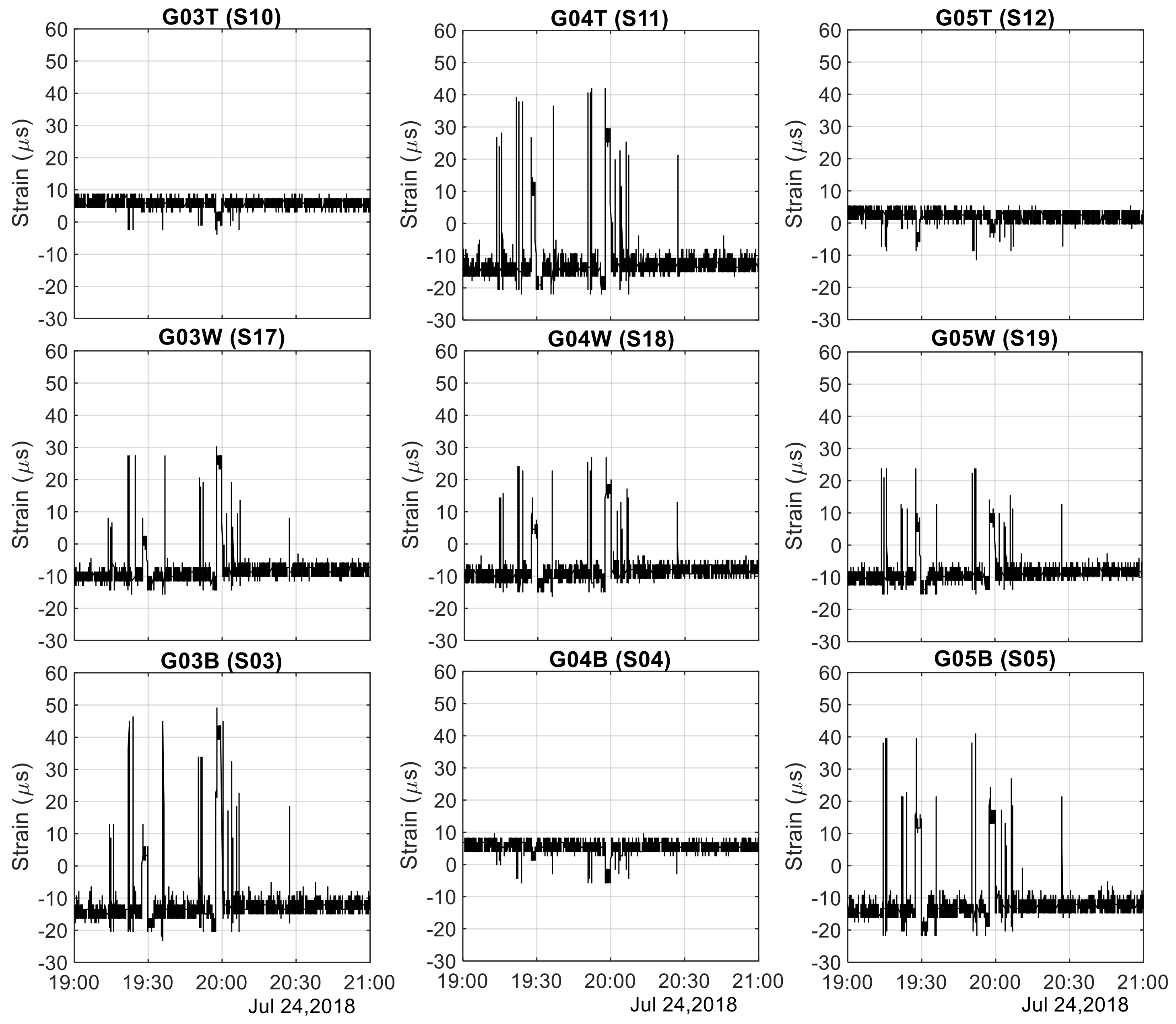





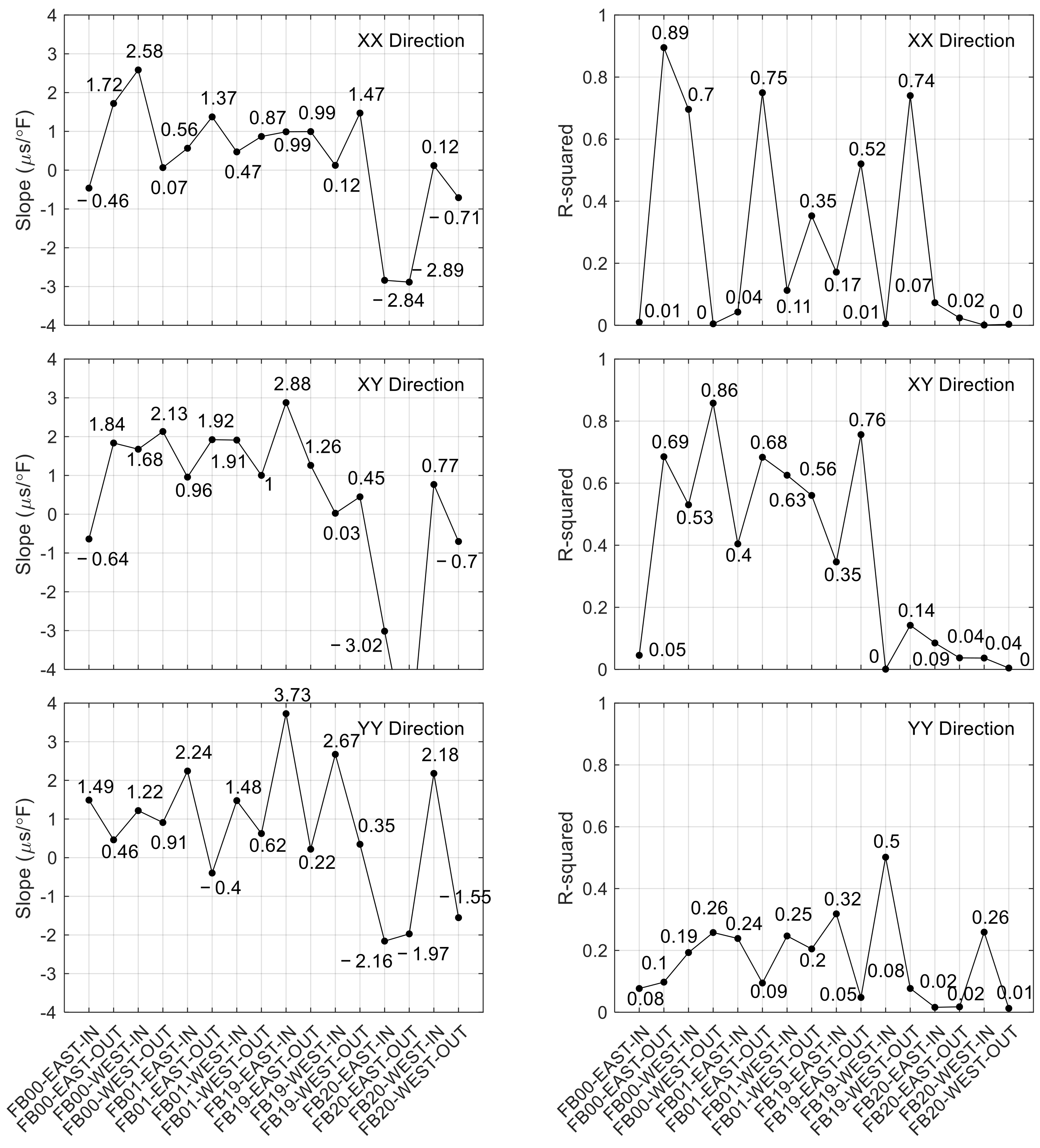


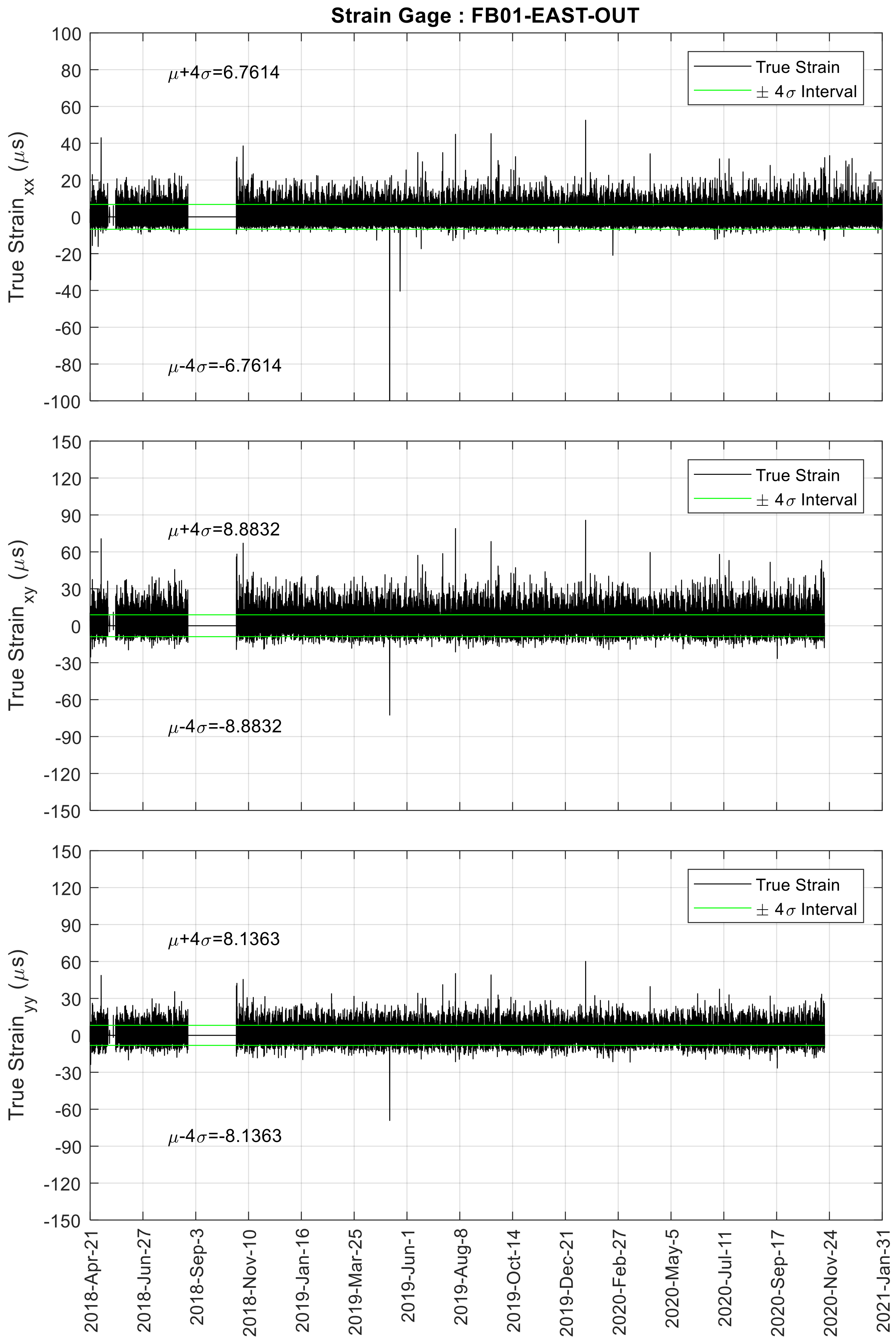

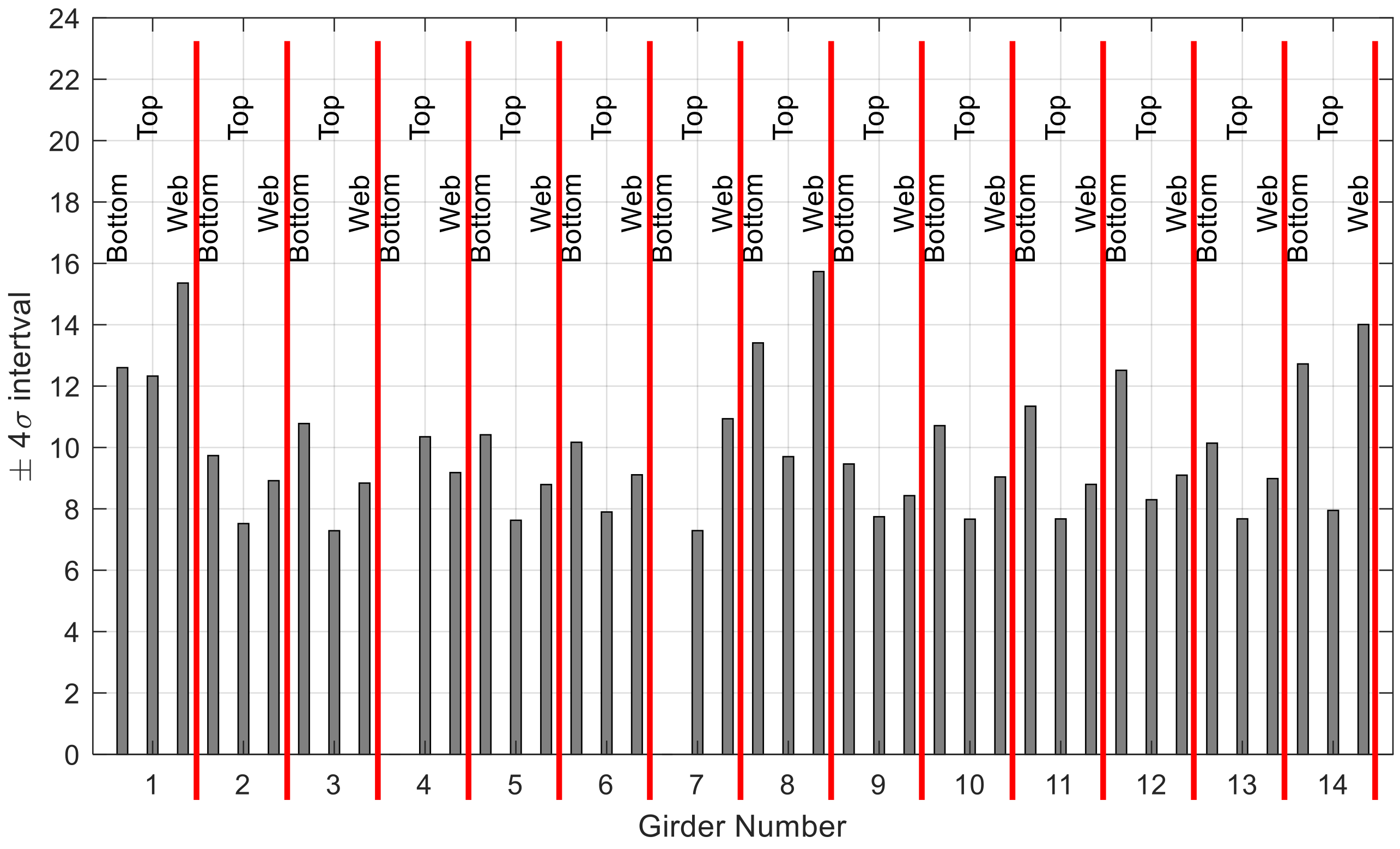
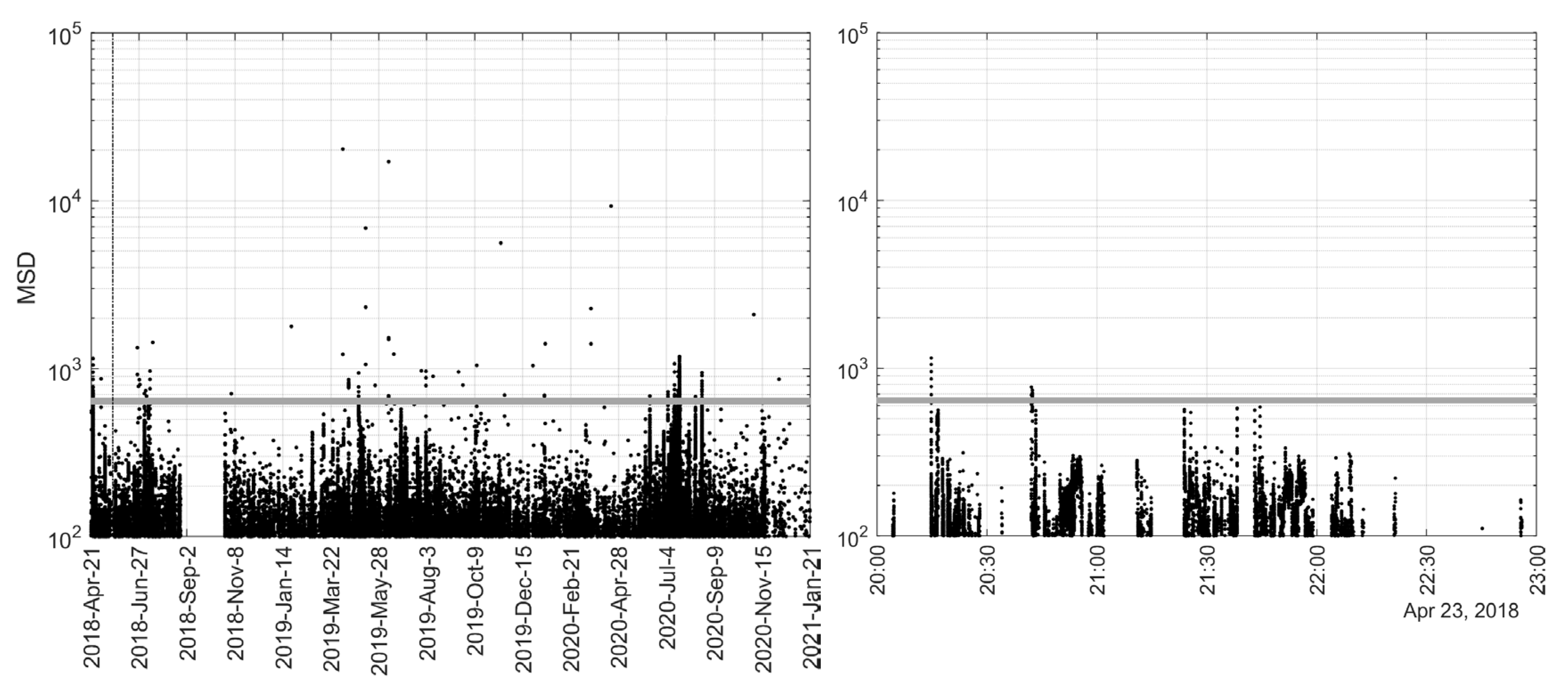

| CONCRETE | Deck or slab | 4000 psi |
| STEEL | Cables (only for Birmingham Bridge) | Grade 250 steel |
| Other steel components (beams, girders, etc.) | Grade 60 steel |
| Damage Scenario | Description |
|---|---|
| (a) | |
| 1 | The modulus of elasticity of steel was reduced by 5%. |
| 2 | The modulus of elasticity of concrete was reduced by 10%. |
| 3 | The contact of the stringers (the third counting from the curbs) with FB01 and FB19 changed from expandable to fixed (locked). |
| 4 | Simultaneous absence of one of the inner cables above FB01 and FB19 |
| 5 | Two diaphragms that are approximately under the front axle of the truck were removed. |
| 6 | Bolt loosening at the connection of FB01 to the west tie girder (the tie girder that is at the right-hand side of the southbound direction). |
| (b) | |
| 1 | The modulus of elasticity of steel was reduced by 5%. |
| 2 | The modulus of elasticity of the concrete deck was reduced by 15%. |
| 3 | Removed diaphragms and diagonal bracing members from the middle of Span 12 (west side) and Span 13 (east side). |
| 4 | The modulus of elasticity of the middle girder was reduced by 10%. |
| 5 | Beam end severe corrosion is modeled. |
| 6 | Repair Scenario 1: a rectangular plate was added to the location of the previous damage scenario to repair the modeled corrosion. |
| (c) | |
| 1 | A total of 0.1 inches of corrosion at the bottom flange of each girder. |
| 2 | A total of 0.06 in corrosion at the web of each girder. |
| 3 | The modulus of elasticity of the girders’ steel was reduced by 5%. |
| 4 | Damage Scenario 4: the modulus of elasticity of the steel for Girder 3 (G3) and Girder 12 (G12) was reduced by 10%. |
| 5 | Seven diaphragms (steel bracing) were removed. |
| 6 | The contact of Girder 5 (G5) and Girder 9 (G9) with the deck was changed from “Bounded” to “No separation” (loss of composite behavior). |
| (a) | ||||||||||
| Strain in XX Direction (με) | Strain in YY Direction (με) | |||||||||
| Measured | Predicted | Measured | Predicted | |||||||
| Sensor No. | Truck Crossings | Pristine | Damage 3 | Diff. (%) | Test 1 | Test 5 | Pristine | Damage 3 | Diff. (%) | |
| FB01-East-IN | −73.40 | −57.50 | −62.72 | −61.10 | −2.6% | −81.40 | −71.10 | −76.61 | −88.29 | 15.2% |
| FB01-East-Out | 16.20 | 19.30 | 14.08 | 14.24 | 1.1% | 14.70 | 18.40 | 19.22 | 20.43 | 6.3% |
| FB19-East-IN | −50.40 | −49.50 | −60.91 | −61.92 | 1.7% | −79.40 | −77.50 | −72.67 | −76.09 | 4.7% |
| FB19-East-Out | 15.60 | 18.30 | 15.19 | 15.04 | −1.0% | 12.30 * | 11.90 * | 20.53 | 19.95 | −2.8% |
| (b) | ||||||||||
| Strain in XX Direction (με) | Strain in YY Direction (με) | |||||||||
| Measured | Predicted | Measured | Predicted | |||||||
| Sensor No. | Truck Crossings | Pristine | Damage 3 | Diff. (%) | Test 11 | Test 15 | Pristine | Damage 3 | Diff. (%) | |
| FB01-West-IN | −16.10 | −16.20 * | −20.34 | −20.01 | −1.6% | −32.00 * | −29.10 * | −17.15 | −27.03 | 58% |
| FB01-West-Out | 19.00 | 19.00 | 14.34 | 14.03 | −2.2% | 19.70 | 20.10 | 23.49 | 22.56 | −4.0% |
| FB19-West-IN | −15.40 * | −14.90 * | −19.83 | −18.42 | −7.1% | −34.50 * | −31.10 * | −21.80 | −35.06 | 61% |
| FB19-West-Out | 17.90 | 18.40 | 15.74 | 15.47 | −1.7% | 22.00 | 28.00 | 24.56 | 24.14 | −1.7% |
| Sensor No. | Predicted (με) | Diff. (%) | |
|---|---|---|---|
| Pristine | Damage 5 | ||
| S01 | 4.88 | 3.36 | −31.1% |
| S03 | 4.70 | 4.72 | 0.4% |
| S05 | 4.86 | 4.88 | 0.4% |
| S06 | −16.42 | −16.42 | 0.0% |
| S08 | −12.65 | −12.65 | 0.0% |
| S10 | −7.60 | −7.59 | −0.1% |
| S11 | −13.60 | −13.61 | 0.0% |
| S13 | −11.33 | −11.33 | 0.0% |
| S15 | −8.34 | −8.34 | 0.0% |
| S16 | 2.79 | 2.79 | 0.0% |
| S18 | 2.36 | 2.36 | 0.0% |
| S20 | 2.71 | 2.70 | −0.4% |
| Truck is at the Middle of the First Span | ||||
|---|---|---|---|---|
| Sensor No. | Measured Strain (με) | Predicted Strain (με) | Diff. (%) | |
| Pristine | Damage 4 | |||
| 1 | 3.00 | 2.09 | 2.17 | 3.8% |
| 2 | 9.50 | 8.91 | 9.11 | 2.2% |
| 3 | 17.50 | 17.12 | 17.51 | 2.3% |
| 4 | 25.00 | 25.04 | 25.58 | 2.2% |
| 5 | 28.00 | 37.47 | 37.56 | 0.2% |
| 6 | 44.00 | 45.23 | 45.25 | 0.0% |
| 7 | 40.00 | 36.28 | 36.31 | 0.1% |
| 15 | 2.00 | 1.08 | 1.13 | 4.6% |
| 16 | 5.50 | 5.59 | 5.73 | 2.5% |
| 17 | 10.50 | 10.87 | 11.09 | 2.0% |
| 18 | 15.00 | 16.08 | 16.37 | 1.8% |
| 19 | 16.50 | 23.20 | 23.24 | 0.2% |
| 20 | 26.50 | 27.04 | 27.05 | 0.0% |
| 21 | 24.50 | 21.81 | 21.80 | 0.0% |
| Truck is at the Middle of the Second Span | ||||
| Sensor No. | Measured Strain (με) | Predicted Strain (με) | Diff. (%) | |
| Pristine | Damage 4 | |||
| 22 | 3.50 | 2.02 | 2.01 | −0.5% |
| 23 | 10.00 | 9.78 | 9.89 | 1.1% |
| 24 | 18.50 | 18.98 | 19.30 | 1.7% |
| 25 | 30.00 | 29.62 | 30.24 | 2.1% |
| 26 | 41.50 | 42.26 | 43.61 | 3.2% |
| 27 | 48.00 | 47.93 | 48.91 | 2.0% |
| 28 | 33.00 | 31.65 | 32.04 | 1.2% |
| 36 | 2.50 | 1.03 | 1.03 | 0.0% |
| 37 | 6.00 | 5.88 | 5.93 | 0.9% |
| 38 | 10.50 | 11.44 | 11.62 | 1.6% |
| 39 | 16.50 | 18.25 | 18.66 | 2.2% |
| 40 | 23.00 | 24.58 | 25.46 | 3.6% |
| 41 | 29.50 | 29.36 | 29.98 | 2.1% |
| 42 | 18.50 | 18.74 | 18.94 | 1.1% |
| Truck is at the Middle of the First Span | ||||
|---|---|---|---|---|
| Sensor No. | Measured Strain (με) | Predicted Strain (με) | Diff. (%) | |
| Pristine | Damage 5 | |||
| 1 | 3.00 | 2.09 | 1.97 | −5.7% |
| 2 | 9.50 | 8.91 | 8.83 | −0.9% |
| 3 | 17.50 | 17.12 | 17.13 | 0.1% |
| 4 | 25.00 | 25.04 | 25.39 | 1.4% |
| 5 | 28.00 | 37.47 | 37.94 | 1.3% |
| 6 | 44.00 | 45.23 | 45.44 | 0.5% |
| 7 | 40.00 | 36.28 | 35.96 | −0.9% |
| 15 | 2.00 | 1.08 | 1.02 | −5.6% |
| 16 | 5.50 | 5.59 | 5.55 | −0.7% |
| 17 | 10.50 | 10.87 | 10.92 | 0.5% |
| 18 | 15.00 | 16.08 | 16.33 | 1.6% |
| 19 | 16.50 | 23.20 | 23.50 | 1.3% |
| 20 | 26.50 | 27.04 | 27.27 | 0.9% |
| 21 | 24.50 | 21.81 | 21.52 | −1.3% |
| Truck is at the Middle of the Second Span | ||||
| Sensor No. | Measured Strain (με) | Predicted Strain (με) | Diff. (%) | |
| Pristine | Damage 5 | |||
| 22 | 3.50 | 2.02 | 1.93 | −4.5% |
| 23 | 10.00 | 9.78 | 9.69 | −0.9% |
| 24 | 18.50 | 18.98 | 19.03 | 0.3% |
| 25 | 30.00 | 29.62 | 29.74 | 0.4% |
| 26 | 41.50 | 42.26 | 42.67 | 1.0% |
| 27 | 48.00 | 47.93 | 48.04 | 0.2% |
| 28 | 33.00 | 31.65 | 31.54 | −0.3% |
| 36 | 2.50 | 1.03 | 0.97 | −5.8% |
| 37 | 6.00 | 5.88 | 5.81 | −1.2% |
| 38 | 10.50 | 11.44 | 11.48 | 0.4% |
| 39 | 16.50 | 18.25 | 18.33 | 0.4% |
| 40 | 23.00 | 24.58 | 24.91 | 1.3% |
| 41 | 29.50 | 29.36 | 29.50 | 0.5% |
| 42 | 18.50 | 18.74 | 18.66 | −0.4% |
Disclaimer/Publisher’s Note: The statements, opinions and data contained in all publications are solely those of the individual author(s) and contributor(s) and not of MDPI and/or the editor(s). MDPI and/or the editor(s) disclaim responsibility for any injury to people or property resulting from any ideas, methods, instructions or products referred to in the content. |
© 2024 by the authors. Licensee MDPI, Basel, Switzerland. This article is an open access article distributed under the terms and conditions of the Creative Commons Attribution (CC BY) license (https://creativecommons.org/licenses/by/4.0/).
Share and Cite
Enshaeian, A.; Ghahremani, B.; Rizzo, P. Case Studies about Finite Element Modeling and Wireless Sensing of Three Pennsylvania Bridges. Sensors 2024, 24, 1714. https://doi.org/10.3390/s24061714
Enshaeian A, Ghahremani B, Rizzo P. Case Studies about Finite Element Modeling and Wireless Sensing of Three Pennsylvania Bridges. Sensors. 2024; 24(6):1714. https://doi.org/10.3390/s24061714
Chicago/Turabian StyleEnshaeian, Alireza, Behzad Ghahremani, and Piervincenzo Rizzo. 2024. "Case Studies about Finite Element Modeling and Wireless Sensing of Three Pennsylvania Bridges" Sensors 24, no. 6: 1714. https://doi.org/10.3390/s24061714
APA StyleEnshaeian, A., Ghahremani, B., & Rizzo, P. (2024). Case Studies about Finite Element Modeling and Wireless Sensing of Three Pennsylvania Bridges. Sensors, 24(6), 1714. https://doi.org/10.3390/s24061714








